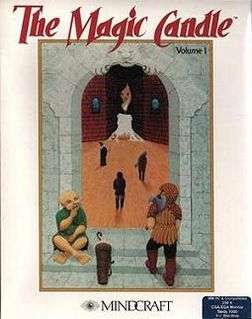The Magic Candle
The Magic Candle is a role-playing video game designed by Ali Atabek and developed and published by Mindcraft in 1989.[1]
| The Magic Candle | |
|---|---|
 | |
| Developer(s) | Mindcraft |
| Publisher(s) | Mindcraft |
| Platform(s) | Apple II, Commodore 64, MS-DOS, PC-9801 |
| Release | 1989 |
| Genre(s) | RPG |
| Mode(s) | Single-player |
Story
In the game, players must assemble a group of six adventurers and journey across the kingdom of Deruvia to keep the demon Dreax imprisoned in the eponymous magic candle, which has begun to melt. The game's world includes several towns and cities, two castles, and several dungeons and towers. Unlike many computer games, one wins not by defeating a final enemy, but by collecting the necessary items and learning the necessary chants in order to preserve the magic candle. Players begin with one adventurer, a human hero called Lukas. Additional adventurers can be found in the game's two castles. Much of The Magic Candle's fun derives from discovering exactly what is needed to preserve the eponymous candle. However, if the candle melts and Dreax escapes, there is no consequence.
Races
There are five races available in this game:
- Dwarves - Very short but exceptionally strong.
- Elves - Tall and slender with special attachment to the forests.
- Halflings - Small charismatic race with large furry feet.
- Man - Or Human.
- Wizards - Wizards are considered a race in this game. This race is similar to the race of Man, but practices magic.
Professions
- Carpenter - Can build shelter for camping.
- Fighter - Skilled in combat.
- Gem-Cutter - Gain extra 1/3 profits from gem sales.
- Knight - Skilled both in combat and in defense.
- Mage - Skilled in Magic. Only Wizards can be mages.
- Mercenary - Offer their services for hire.
- Metal Smith - Repairs weapons faster.
- Ranger - Good hunters and move well in unknown terrain. This is Lukas' profession.
- Tailor - Can make and repair garments. Good for getting jobs in towns.
Realism
The Magic Candle is known to have several traits that increase the realism of the game and of the world of Deruvia:
- Party splitting - Players can split their party into several different groups and have each of them perform a different task, including working at different jobs to earn money in a town.
- Wear and tear - Weapons accumulate wear and tear, and even break if not maintained properly.
- Hunger and fatigue - Characters need to eat, rest, and sleep in order to remain healthy.
- Residences - Players can't go barging into a private home. They have to knock on the door, and know the name of the residence owner.
- Time factor - Shops close during the night and re-open at dawn. NPCs can be in different places at different times of the day.
Japan Release
Japanese company StarCraft, which specialized in localizing Western CRPGs, ported The Magic Candle to the Japanese PC-9801 computer.[2] The port was released in May 1991, two years after the original release, with completely redesigned art and interfaces.
Reception
The Magic Candle was reviewed in 1989 in Dragon #148 by Hartley, Patricia, and Kirk Lesser in "The Role of Computers" column. The reviewers gave the game 3 out of 5 stars.[3] Scorpia of Computer Gaming World in 1989 gave the game a very positive review, noting that killed monsters tend to stay dead, a welcome change from the "endless wave" of other CRPGs. Criticisms included the relatively slow combat and the inability to quickly find people or shops in town.[4] The magazine later recognized it as 1989's Role-Playing Game of the Year, describing it as "extensive, well-written, and balanced".[5] In 1993 Scorpia approved of the "superior nonviolent ending" and stated that the 1989 award was well-deserved.[6]
Scorpia in 1993 was more critical of The Magic Candle III, with objections including a shortage of money at the start forcing the player to grind instead of questing, and imbalanced dungeons. She concluded that it "is a dull game" which failed to meet the expectations the first one set,[7] "only for the hard-core fan of the series", and ended the series "on a mediocre note".[6]
Legacy
The Magic Candle was successful enough to have sequels: The Magic Candle II: The Four and Forty (1991), and The Magic Candle III (1992). The Keys to Maramon (1990) was an action-title spinoff. Bloodstone: An Epic Dwarven Tale, released in 1993, is a prequel to The Magic Candle. The series also spawned two spin-offs: Siege (1992) and its sequel Ambush at Sorinor (1993) are tactical strategy games, both taking place in the world of The Magic Candle.
References
- Barton, Matt (2007-02-23). "Part 2: The Golden Age (1985-1993)". The History of Computer Role-Playing Games. Gamasutra. Archived from the original on 2009-03-12. Retrieved 2009-03-26.
- "Toshio Sato on StarCraft Inc., Phantasie IV and Tunnels & Trolls". Retrospective Interview. RPG Codex. 2014-08-20. Retrieved 2016-09-13.
- Lesser, Hartley; Lesser, Patricia; Lesser, Kirk (August 1989). "The Role of Computers". Dragon (148): 68–73.
- Scorpia (April 1989). "Keeper of the Flame". Computer Gaming World. pp. 28–30. Retrieved 25 March 2016.
- "Game of the Year Awards". Computer Gaming World. October 1989. pp. 8, 41. Retrieved 25 March 2016.
- Scorpia (October 1993). "Scorpia's Magic Scroll Of Games". Computer Gaming World. pp. 34–50. Retrieved 25 March 2016.
- Scorpia (May 1993). "Scorpia Orckiller Lights Mindcraft's Magic Candle III". Computer Gaming World. p. 32. Retrieved 7 July 2014.
External links
- The Magic Candle series at MobyGames
- The Magic Candle can be played for free in the browser at the Internet Archive
- Jason Spangler's Magic Candle page
- The History of Computer Role-Playing Games Part 2: The Golden Age (1985-1993)